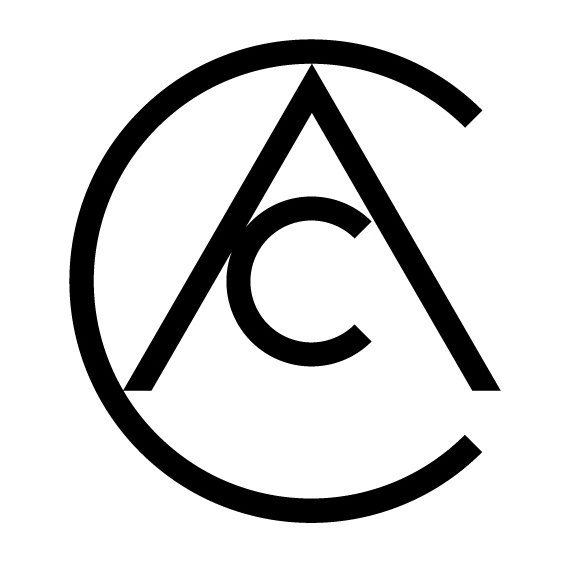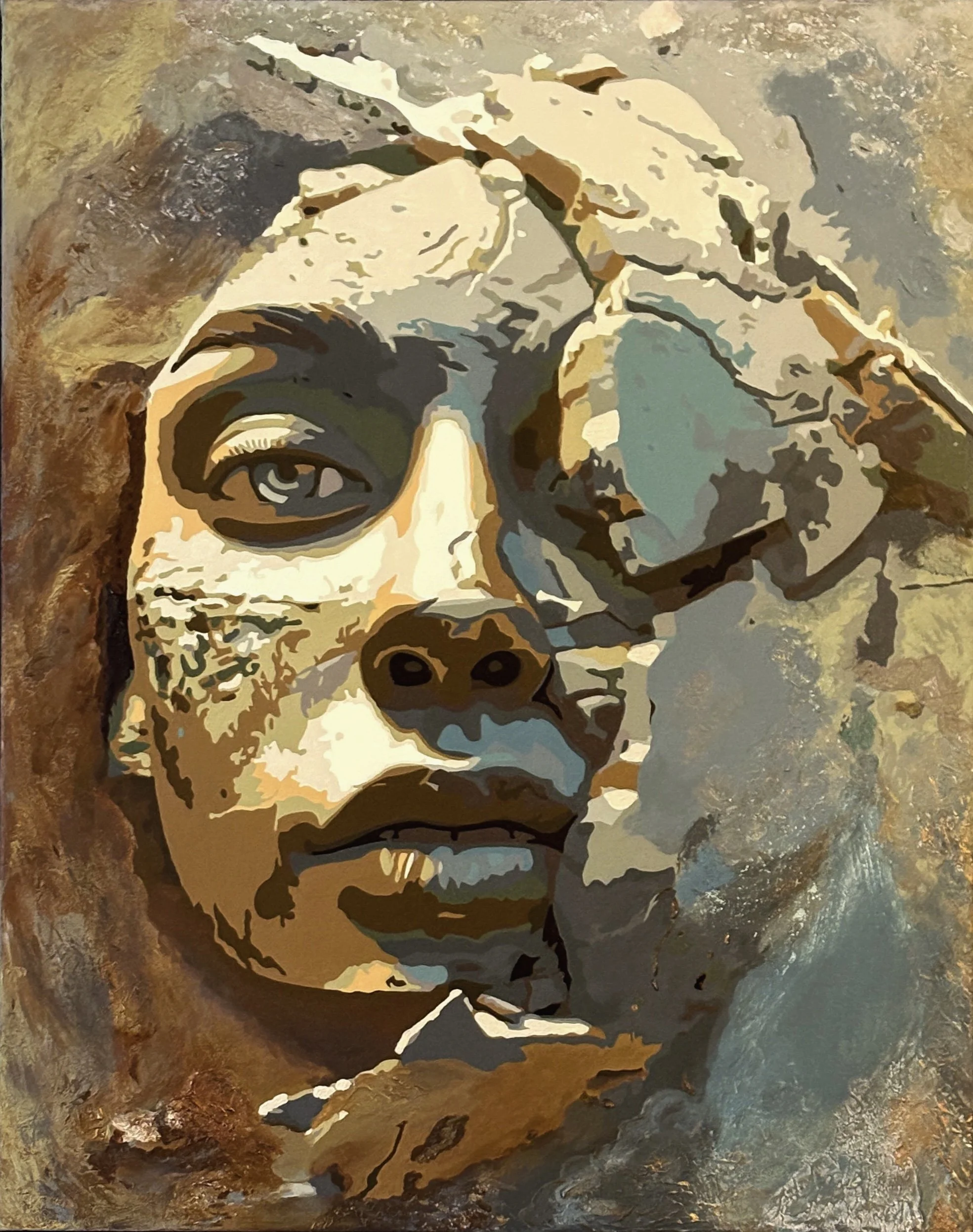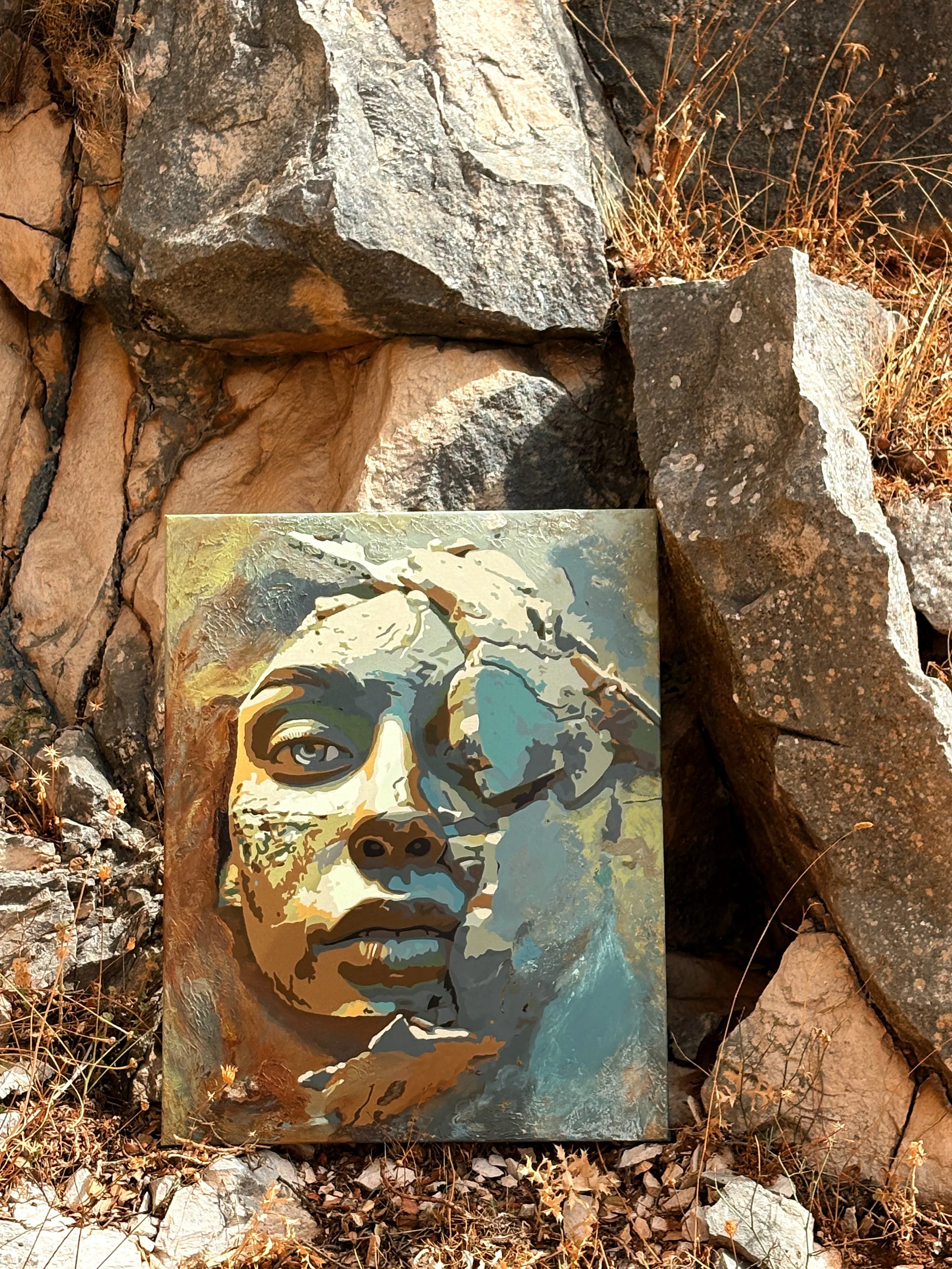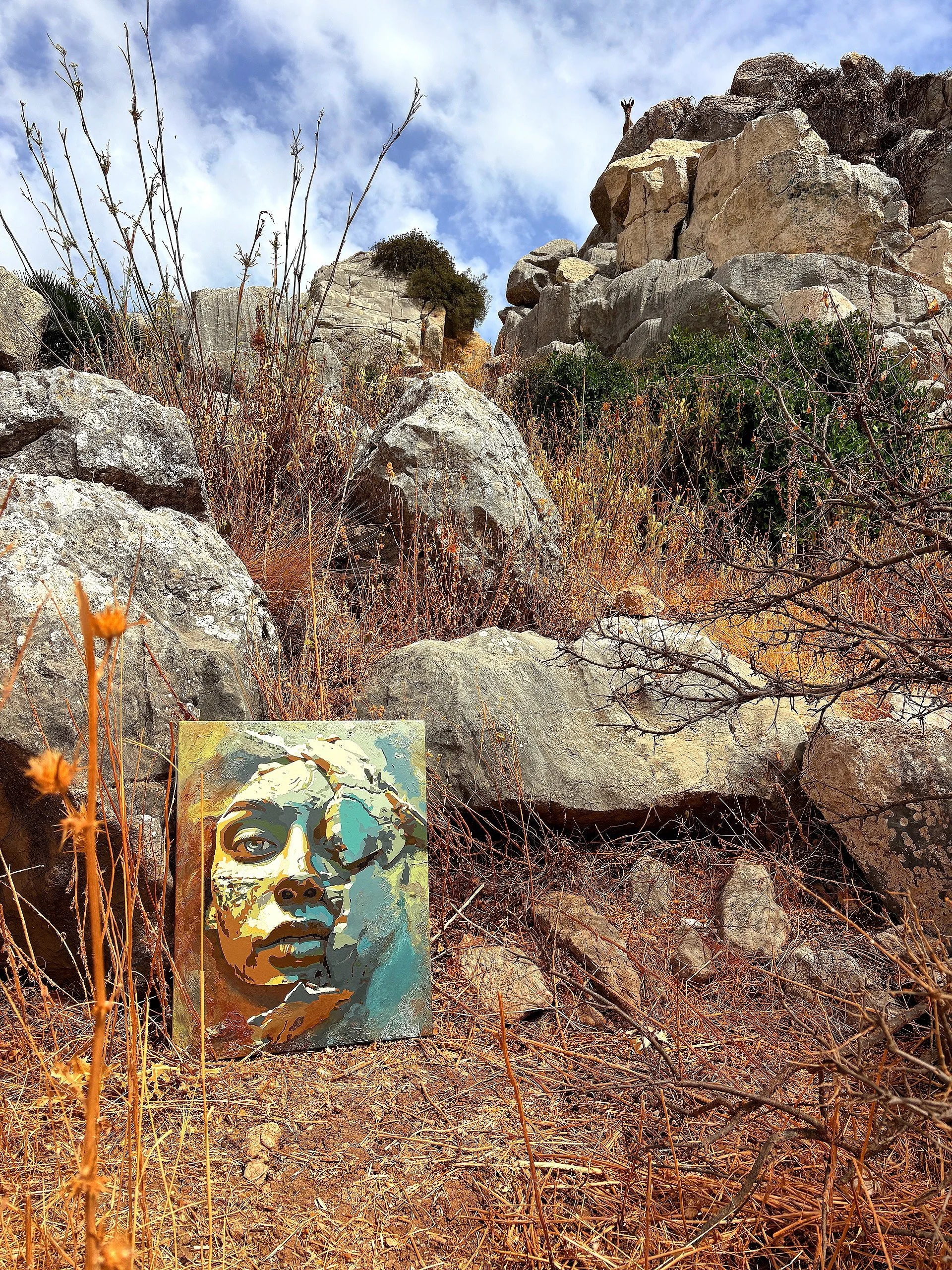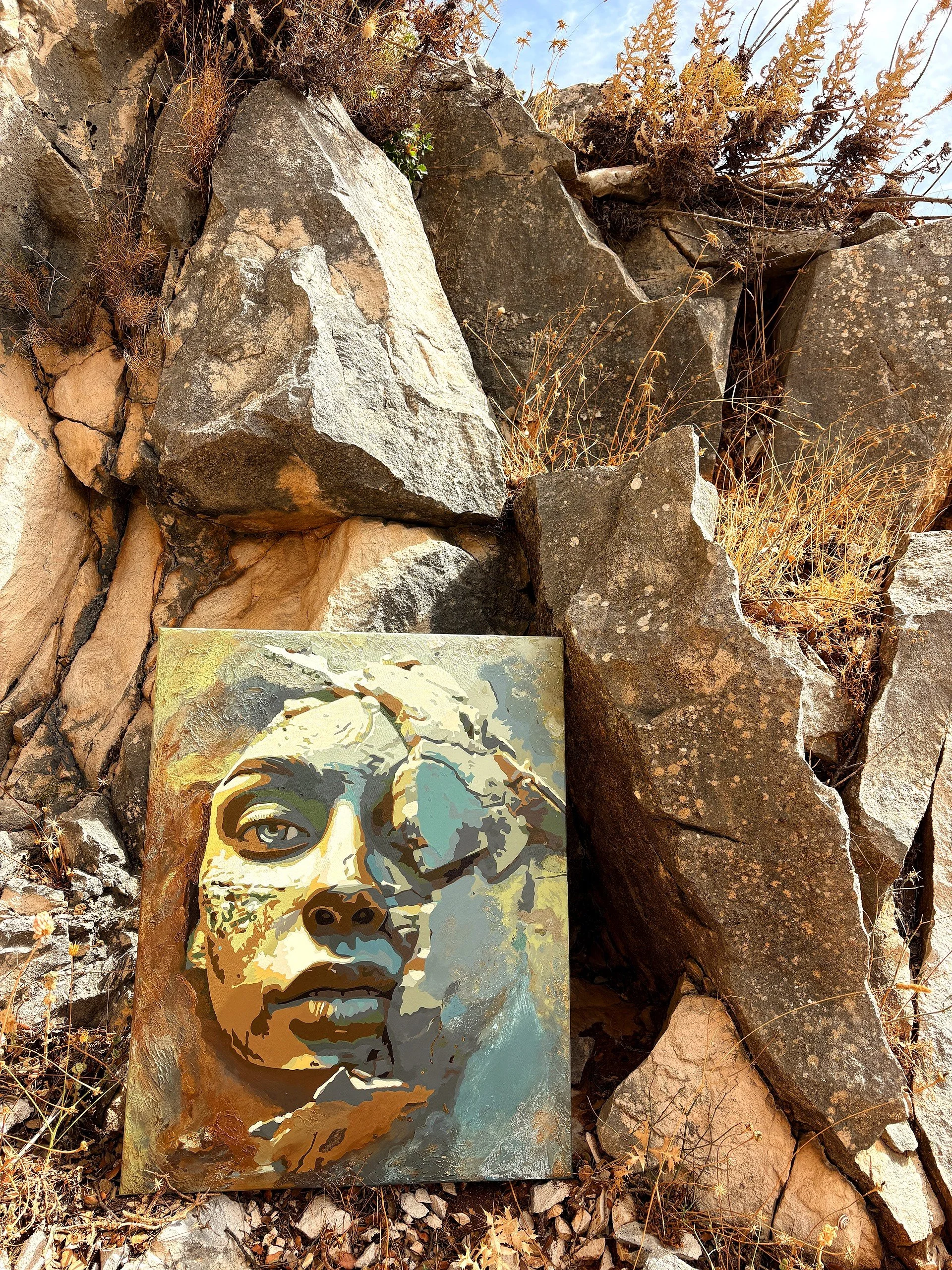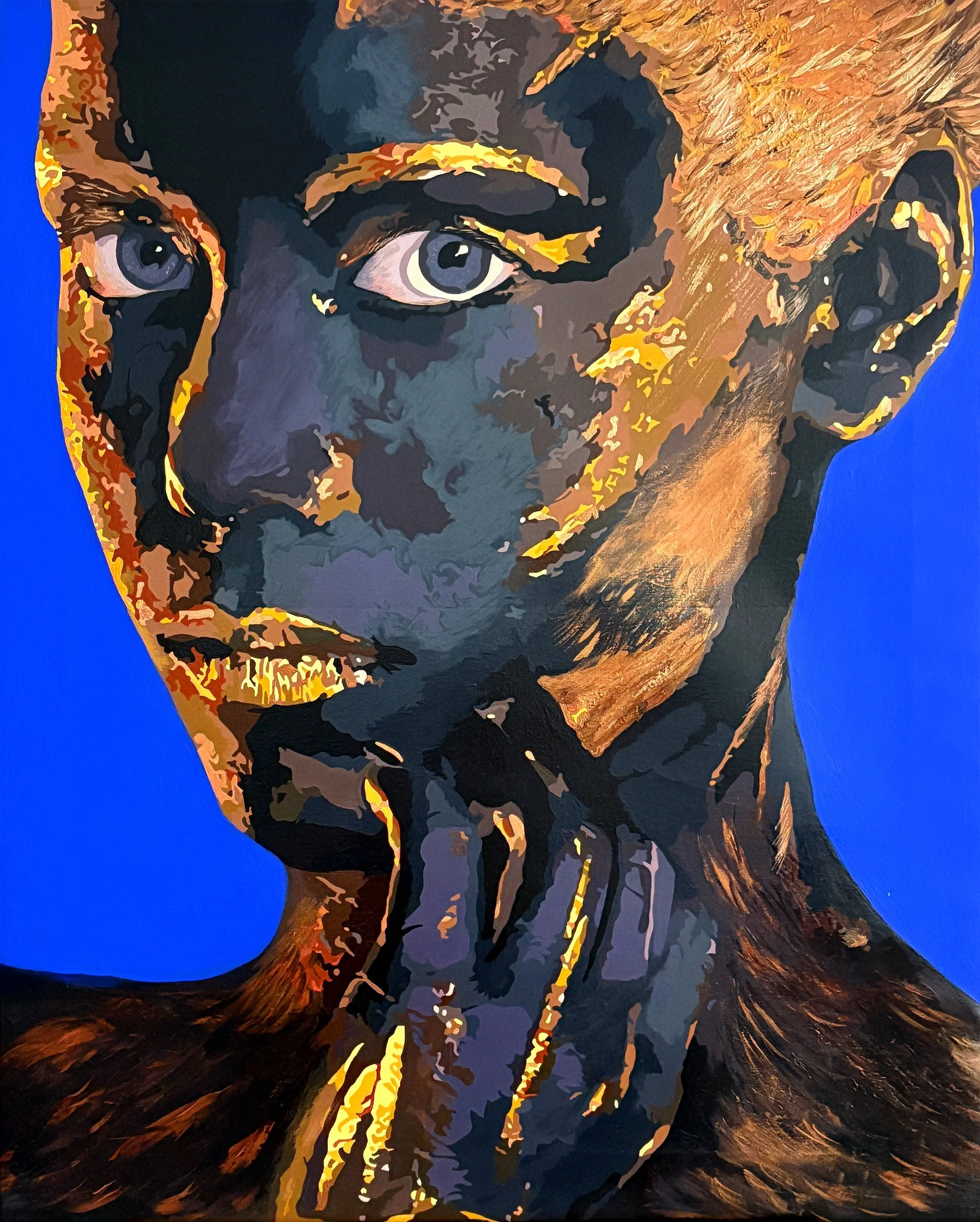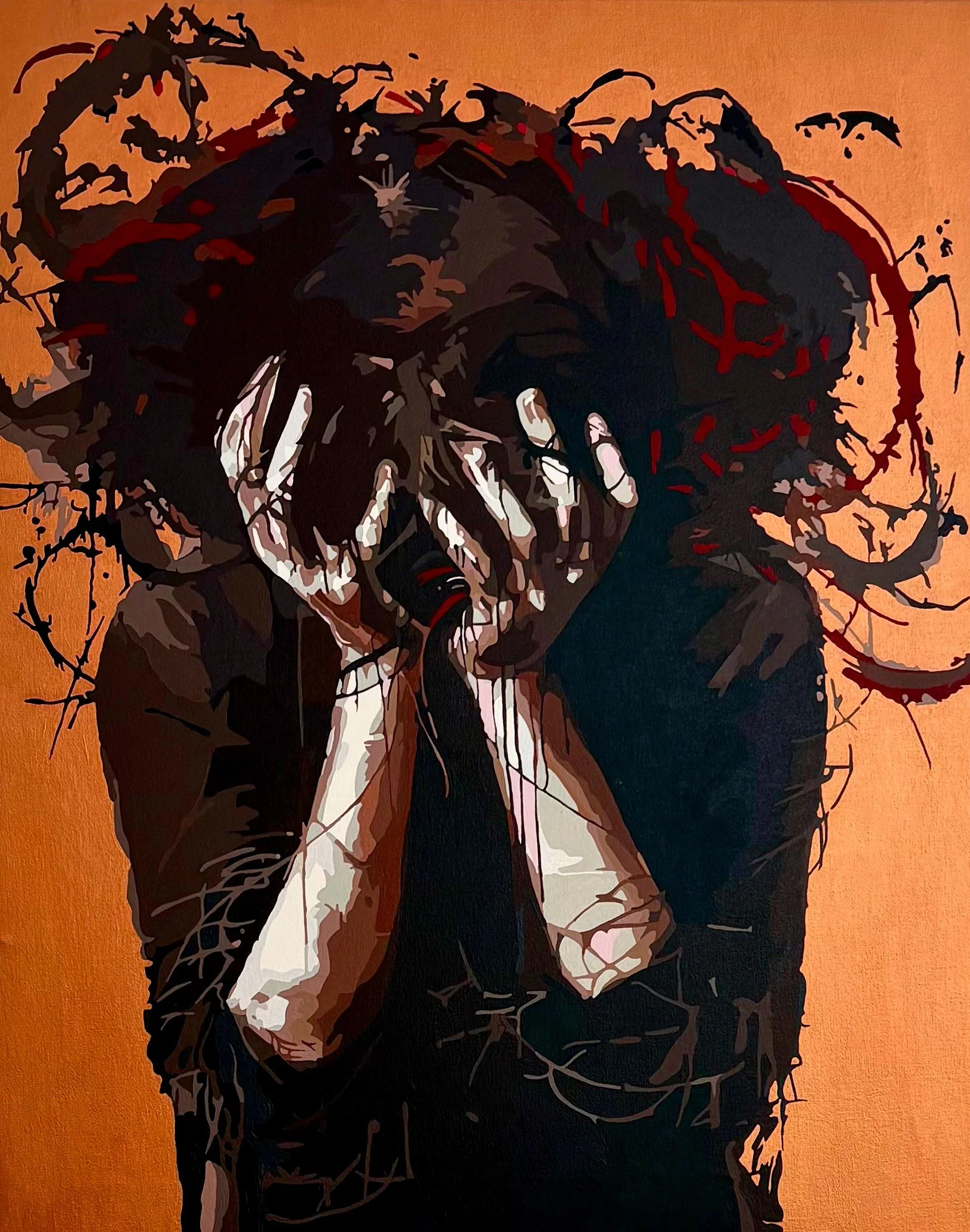Alisa Chernova
Artist Portrait Alisa Chernova, 2025, Photography
Alisa Chernova enters the contemporary art scene not as a painter alone but as a psychotherapist turned artist, who has transformed the consulting room into the canvas. Few artists embody with such clarity the conviction that painting may serve as a visual laboratory for human subjectivity, where the fragmentary self can be staged, tested, and reconstituted. Her background as a Gestalt therapist infuses every brushstroke with the weight of psychological encounter: each canvas is not a representation but a session, not a depiction but a dialogue.
The series In the Company of Sigmund Freud demonstrates this dual authorship — Freud’s psychoanalytic legacy meeting Chernova’s painterly agency, unfolding as a journey through depression, anxiety, despair, and culminating in the philosophical suspension of identity in Who Am I? Monologue with Myself (2025). If Freud once proposed that dreams are the royal road to the unconscious, Chernova suggests that painting may be the contemporary threshold where unconscious states crystallize into form.
Across In the Company of Sigmund Freud, the viewer is confronted with images that refuse to comfort. The works Depression (2024), Deep Depression (2024), Anxiety (2024), and Despair (2025) form not a clinical progression but a topology of psychic states. They are zones through which the subject wanders — not unlike Freud’s own metaphor of the psyche as a city layered with ruins, where past and present cohabit.
In Despair, a figure collapses inward, hands covering the face as if to stem an inner hemorrhage. The swirling darkness of the composition, punctured with flashes of blood-like crimson, renders the psyche as both shroud and battlefield. Here, Chernova’s painterly strategy is less about figuration than about the distortion of gesture: hands conceal yet expose, the body hides yet betrays.
Anxiety, by contrast, replaces collapse with confrontation. The fractured surface of the skin, glowing like fissures in volcanic stone, articulates the nervous system under pressure, a body cracking under the strain of psychic fire. The electric green ground heightens the dissonance, a chromatic violence that positions anxiety not as weakness but as an unbearable over-charged presence.
Through these canvases, Chernova charts the oscillations of the psyche with both the empathy of the therapist and the audacity of the painter. If modernism sought purity of form, she seeks impurity of feeling — the messy, uncontainable residues of interior life.
The true philosophical center of Chernova’s practice is found in Who Am I? Monologue with Myself, the culminating work of the Freud cycle. Unlike the earlier canvases that present identifiable states: despair, anxiety, depression, this painting is not diagnostic but ontological. It asks not what ails me? But what am I?
The face that emerges from the fractured surface of stone is not entirely human, nor entirely sculptural. It is caught between mask and flesh, ruin and resurrection. The features appear carved, as if by geological time, and yet the gaze is startlingly alive. One eye peers through a break in the rock, as if consciousness itself were straining to pierce through layers of sedimented identity.
This is not a painting about illness; it is a painting about being. It stages the monologue as a double movement: the self interrogates itself, even as it confronts the impossibility of ever arriving at a stable answer.
What makes this work remarkable in the context of contemporary painting is its refusal of spectacle. At a time when art often succumbs to the logics of Instagram visibility, Chernova insists on opacity. The painting’s power lies not in instant legibility but in its resistance. The longer one looks, the more one realizes that the cracks in the stone are not wounds but inscriptions, codes, the silent writing of existence itself.
Rosalind Krauss often insisted that modern sculpture was not merely form but “a complex of terms,” a field of signifiers. In the same sense, Chernova’s canvases are not images but psychoanalytic objects. They belong to the realm of what Lacan would call objet a, that which both reveals and withholds, that which organizes desire.
Who Am I? is precisely such an object: it offers the face, yet denies the whole; it gives the gaze, yet fractures it with stone; it opens identity, yet closes it in the silence of monologue. The viewer becomes the analyst, invited into the session, compelled to listen to the mute speech of the painting.
This, perhaps, is where Chernova’s dual training as psychotherapist and artist achieves its most radical synthesis. She does not paint to illustrate therapy; she paints to enact it. The viewer’s encounter with her work is itself therapeutic, not because it consoles but because it confronts. One cannot look at Who Am I? without becoming implicated in one’s own interior dialogue.
To situate Chernova in the contemporary art landscape is to recognize her as part of a lineage of artists who refuse the separation of aesthetics and philosophy. She belongs with those who treat painting not as decoration but as inquiry: Anselm Kiefer, who inscribes memory into ash and lead; Marlene Dumas, who stains the canvas with psychic intensity; and Adrian Ghenie, who dismembers history to expose its unconscious.
Yet Chernova’s contribution is distinct. Where Kiefer turns to collective trauma and Dumas to eroticized subjectivity, Chernova insists on the therapeutic as an artistic category. In doing so, she extends the role of art into the social fabric: her paintings become sites where the pathologies of contemporary life - depression, anxiety, despair — are not stigmatized but dignified, given form, given space.
In the global art circuit, with exhibitions in London, Paris, Tokyo, New York, and Hong Kong, her work resonates not because it flatters collectors but because it addresses universal afflictions. To see her paintings on the Times Square screen is not to see an advertisement; it is to witness a rupture, a moment when mass spectatorship is forced to pause, to reflect, to ask: Who am I?
Chernova has spoken of her interest in control, illusions, and the coded rhythm of life. These are not casual terms but philosophical anchors. Control appears in her work as both necessity and trap: the gesture of covering one’s face in Despair speaks to the desperate attempt to contain what cannot be contained. Illusion emerges in the fractures of Anxiety, where the solidity of skin is revealed as a surface under constant threat of rupture. Rhythm is the invisible pulse that holds the series together, the oscillation between collapse and emergence, silence and monologue.
In Who Am I?, these themes converge. The stone face is controlled, immobilized, yet fissured by illusion; the rhythm of cracks across the surface is both chaotic and patterned. This is the coded rhythm of existence itself, which Freud described as repetition compulsion, and which Chernova re-inscribes as a visual motif.
In a world increasingly defined by burnout, social fragmentation, and crises of identity, Chernova’s work is not merely relevant; it is urgent. Her canvases give visual dignity to experiences often relegated to silence or stigma. By staging depression and anxiety not as failures but as states of being, she challenges the cultural narrative that equates worth with productivity.
Moreover, her art reintegrates the therapeutic into the public sphere. Where therapy is often confined to private consultation, Chernova democratizes it by placing it on canvas, in galleries, and even on the screens of Times Square. She insists that the exploration of inner states is not a private luxury but a collective necessity.
At the heart of Chernova’s oeuvre is the conviction that the authentic self is not given but constructed, not found but created. Who Am I? Monologue with Myself enacts this conviction with startling clarity. The self is not a mask to be removed, but a monologue to be sustained.
The painting does not answer the question Who am I?; it stages it, again and again, as an unresolvable inquiry. In doing so, it affirms the self as process, as rhythm, as illusion, as fracture. And this, perhaps, is its greatest gift: to liberate identity from the demand for finality, and to open it to the infinite play of becoming.
It is tempting to call Chernova a “new voice” in contemporary art. But this risks understating the depth of her achievement. She is not simply a new participant in the art world; she is a necessary one, whose practice redefines the stakes of painting in the twenty-first century.
Her canvases remind us that art is not entertainment but encounter, not commodity but confrontation. In an era saturated with images, she produces not spectacles but questions. And in Who Am I? Monologue with Myself, she has given us one of the most urgent questions of our time.
Alisa Chernova stands not on the periphery but at the philosophical core of contemporary practice. Her work demonstrates that painting, when joined with psychoanalysis, can still perform what we most desperately need: to hold up a mirror that does not flatter, but that compels us to ask, Who am I?
To grasp the full significance of Alisa Chernova’s work, one must situate it not only within the history of art but within the ethical demands of our present. In an epoch marked by what Byung-Chul Han has described as the “burnout society,” where the imperative of self-optimization erodes the possibility of genuine reflection, Chernova insists on slowing time. Her canvases demand that we pause, that we endure the difficulty of looking into faces that are not smiling, not performative, not immediately consumable. They are faces fractured by doubt, corroded by despair, ignited by anxiety, and yet luminous with the persistence of being.
In this sense, Chernova’s practice is an act of resistance. She resists the commodification of affect, the pressure to aestheticize trauma into a digestible spectacle. Instead, she renders psychic pain as form, giving it the dignity of structure, the depth of color, the endurance of stone. This resistance is not nihilistic but profoundly hopeful, for by dignifying inner states, she returns to the viewer the possibility of recognition. We see ourselves, not as perfected images, but as fractured beings struggling toward authenticity.
The importance of Who Am I? Monologue with Myself lies precisely in this ethical gesture. By staging the self as an unfinished question, Chernova liberates us from the tyranny of fixed identity. She proposes instead that authenticity is not stability but dialogue, not essence but process. In doing so, she reframes the role of art in society: not to provide answers, but to keep alive the most difficult and necessary questions.
Her place in contemporary art, therefore, is not ancillary but central. She joins the lineage of artists who expand the function of art beyond beauty, beyond representation, into the domain of philosophy and therapy, where the work becomes both object and interlocutor. Alisa Chernova’s paintings remind us that to see is to think, and to think is to live more fully. Her canvases, like mirrors cracked yet luminous, return us to ourselves with the insistence that we, too, must ask: Who am I?
By Marta Puig
Editor Contemporary Art Curator Magazine
Who Am I? Monologue with Myself, 2025,acrylic on canvas, 80/65cm
Who Am I? Monologue with Myself, 2025,acrylic on canvas, 80/65cm
Who Am I? Monologue with Myself, 2025, acrylic on canvas, 80/65
Who Am I? Monologue with Myself, 2025, acrylic on canvas, 80/65cm
Who Am I? Monologue with Myself, 2025, acrylic on canvas, 80/65cm
Rain Man, 2925, acrylic on canvas, 89/65cm
Despair, 2025, acrylic on canvas, 80/65cm
Anxiety, 2024, acrylic on canvas, 80/65cm
Deep Depression, 2024, acrylic on canvas, 80/65 cm
